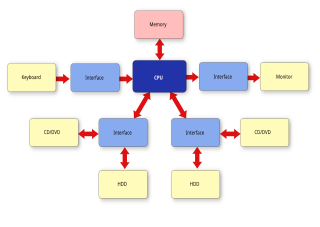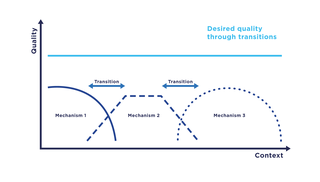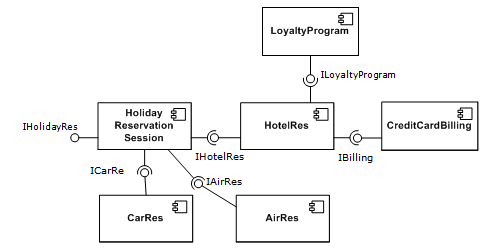In computer programming and software design, code refactoring is the process of restructuring existing computer code—changing the factoring—without changing its external behavior. Refactoring is intended to improve the design, structure, and/or implementation of the software, while preserving its functionality. Potential advantages of refactoring may include improved code readability and reduced complexity; these can improve the source code's maintainability and create a simpler, cleaner, or more expressive internal architecture or object model to improve extensibility. Another potential goal for refactoring is improved performance; software engineers face an ongoing challenge to write programs that perform faster or use less memory.

Software architecture is the set of structures needed to reason about a software system and the discipline of creating such structures and systems. Each structure comprises software elements, relations among them, and properties of both elements and relations.
In software engineering, a design pattern describes a relatively small, well-defined aspect of a computer program in terms of how to write the code.

Malcolm Douglas McIlroy is an American mathematician, engineer, and programmer. As of 2019 he is an Adjunct Professor of Computer Science at Dartmouth College. McIlroy is best known for having originally proposed Unix pipelines and developed several Unix tools, such as spell, diff, sort, join, graph, speak, and tr. He was also one of the pioneering researchers of macro processors and programming language extensibility. He participated in the design of multiple influential programming languages, particularly PL/I, SNOBOL, ALTRAN, TMG and C++.
In software engineering, service-oriented architecture (SOA) is an architectural style that focuses on discrete services instead of a monolithic design. SOA is a good choice for system integration. By consequence, it is also applied in the field of software design where services are provided to the other components by application components, through a communication protocol over a network. A service is a discrete unit of functionality that can be accessed remotely and acted upon and updated independently, such as retrieving a credit card statement online. SOA is also intended to be independent of vendors, products and technologies.
In computer programming, a software framework is an abstraction in which software, providing generic functionality, can be selectively changed by additional user-written code, thus providing application-specific software. It provides a standard way to build and deploy applications and is a universal, reusable software environment that provides particular functionality as part of a larger software platform to facilitate the development of software applications, products and solutions.
Modular programming is a software design technique that emphasizes separating the functionality of a program into independent, interchangeable modules, such that each contains everything necessary to execute only one aspect of the desired functionality.
In software development, code reuse, also called software reuse, is the use of existing software, or software knowledge, to build new software, following the reusability principles.
Software prototyping is the activity of creating prototypes of software applications, i.e., incomplete versions of the software program being developed. It is an activity that can occur in software development and is comparable to prototyping as known from other fields, such as mechanical engineering or manufacturing.
Architecture description languages (ADLs) are used in several disciplines: system engineering, software engineering, and enterprise modelling and engineering.
A software factory is a structured collection of related software assets that aids in producing computer software applications or software components according to specific, externally defined end-user requirements through an assembly process. A software factory applies manufacturing techniques and principles to software development to mimic the benefits of traditional manufacturing. Software factories are generally involved with outsourced software creation.

A system architecture is the conceptual model that defines the structure, behavior, and more views of a system. An architecture description is a formal description and representation of a system, organized in a way that supports reasoning about the structures and behaviors of the system.
Domain engineering, is the entire process of reusing domain knowledge in the production of new software systems. It is a key concept in systematic software reuse and product line engineering. A key idea in systematic software reuse is the domain. Most organizations work in only a few domains. They repeatedly build similar systems within a given domain with variations to meet different customer needs. Rather than building each new system variant from scratch, significant savings may be achieved by reusing portions of previous systems in the domain to build new ones.
Douglas Taylor "Doug" Ross was an American computer scientist pioneer, and chairman of SofTech, Inc. He is most famous for originating the term CAD for computer-aided design, and is considered to be the father of Automatically Programmed Tools (APT), a programming language to drive numerical control in manufacturing. His later work focused on a pseudophilosophy he developed and named Plex.

A view model or viewpoints framework in systems engineering, software engineering, and enterprise engineering is a framework which defines a coherent set of views to be used in the construction of a system architecture, software architecture, or enterprise architecture. A view is a representation of the whole system from the perspective of a related set of concerns.
Metamorphic testing (MT) is a property-based software testing technique, which can be an effective approach for addressing the test oracle problem and test case generation problem. The test oracle problem is the difficulty of determining the expected outcomes of selected test cases or to determine whether the actual outputs agree with the expected outcomes.
Software architecture description is the set of practices for expressing, communicating and analysing software architectures, and the result of applying such practices through a work product expressing a software architecture.

T.H. Tse is a Hong Kong academic who is a professor and researcher in program testing and debugging. He is ranked internationally as the second most prolific author in metamorphic testing. According to Bruel et al., "Research on integrated formal and informal techniques can trace its roots to the work of T.H. Tse in the mid-eighties." The application areas of his research include object-oriented software, services computing, pervasive computing, concurrent systems, imaging software, and numerical programs. In addition, he creates graphic designs for non-government organizations.
Software intelligence is insight into the inner workings and structural condition of software assets produced by software designed to analyze database structure, software framework and source code to better understand and control complex software systems in information technology environments. Similarly to business intelligence (BI), software intelligence is produced by a set of software tools and techniques for the mining of data and the software's inner-structure. Results are automatically produced and feed a knowledge base containing technical documentation and blueprints of the innerworking of applications, and make it available to all to be used by business and software stakeholders to make informed decisions, measure the efficiency of software development organizations, communicate about the software health, prevent software catastrophes.

Transition refers to a computer science paradigm in the context of communication systems which describes the change of communication mechanisms, i.e., functions of a communication system, in particular, service and protocol components. In a transition, communication mechanisms within a system are replaced by functionally comparable mechanisms with the aim to ensure the highest possible quality, e.g., as captured by the quality of service.






